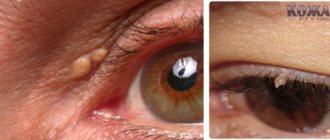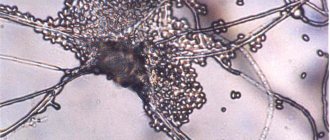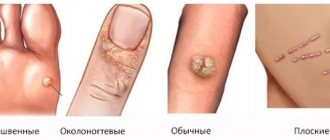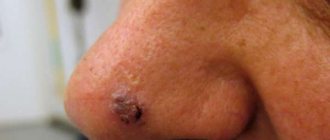Reasons for appearance
Red papillomas often form in people over 30 years of age. Most often this is a symptom, not a disease. Their appearance may indicate a weakened immune system or the presence of various types of pathologies. Therefore, if a red tumor appears on the body, it is better to undergo a medical examination, checking the body for infections and diseases.
The main cause of red moles is the human papillomavirus (HPV). This pathogen infects about 80% of the world's population. It spreads both through household means (contact with the carrier, his personal belongings, hygiene products) and sexually.
The papillomavirus does not detect itself for a long time. Sometimes the hidden (incubation) period lasts for years, if the body is strong enough and able to withstand external threats. But if immunity decreases due to diseases or other negative factors, the pathogen makes itself felt.
Provoking factors:
- HIV infection.
- Various chronic diseases, infections.
- Psychological problems, nervous overstrain, stress, prolonged overwork.
- Improper lifestyle, disrupted sleep patterns, unbalanced diet. Lack of physical activity. Lack of vitamins, minerals and trace elements.
Red growths are localized on the surface of the skin. They can form anywhere: on the head, neck, groin and genitals.
Reasons for appearance:
- Increased vascular permeability due to thinning of the vascular walls. If the body is infected with any infections or is weakened, then the vessels allow, in addition to plasma, other components of the blood.
- Red papillomas also appear on the body in children. Although medicine is not completely clear why this happens, many doctors believe that the reason for this is viral diseases suffered by the child’s mother during pregnancy.
- Red growths can be one of the symptoms of gastrointestinal pathologies. In particular, if the formations are localized on the skin of the body (abdomen, back, chest) and do not disappear if pressure is applied to them, this may be a sign of pancreatitis. Pathologies of the pancreas are a common cause of papillomas.
- If the appearance of growths is accompanied by fever and a feeling of weakness, this may indicate the presence of meningitis.
- This type of defect can occur due to hormonal changes.
The main differences between moles
In medical practice, moles are called nevi; they can differ in size and color. In most cases, moles are red, black or brown in color, located at the same level with the skin or protrude slightly above its surface.
Moles, as a rule, appear on the human body from the age of 6 months; the formation process lasts a lifetime and occurs with varying degrees of intensity. The appearance of moles is the result of the accumulation of too much pigment in certain areas of the skin.
It should be noted that nevi themselves are absolutely harmless, but under the influence of certain factors they can degenerate into melanoma in a short time. Melanoma is dangerous due to the rapid development of metastases and death in approximately 80% of cases.
The causes of moles should be noted:
- genetic predisposition;
- hormonal changes;
- accumulation of melanin;
- prolonged exposure to the open sun.
Types of moles
Active growth of nevi is often observed during puberty and pregnancy, which is dictated by an increased amount of hormones produced by the pituitary gland.
Kinds
Papillomas usually have a diameter of 1-2 mm and do not increase. They are characterized by a red or pinkish color, flat or slightly convex shape. The following varieties are distinguished:
- Star-shaped - small capillaries diverge from it in different directions.
- Red spots can be simple or cavernous. Simple ones are located on the surface of the skin, cavernous ones are located under it.
- A rapidly developing large papilloma is called a hemangioma. If such a spot forms, urgent treatment is required.
Types of red papillomas
Depending on what exactly caused the appearance of benign neoplasms on the body, papillomas are divided into 3 types:
- Cavernous hemangioma - has a clear contour, soft structure, the cavity is filled with venous or arterial blood. Does not cause pain upon palpation.
- Branched hemangioma - consists of several small papillomas connected into one neoplasm. It has a darker red color and pulsates when pressed.
- Capillary hemangioma is a small, solitary neoplasm. The most common type of benign neoplasm, which has the most favorable prognosis.
Papillomas can occur not only in adults, but also in newborns. For most people, these red dots are able to disappear on their own. Only in some cases surgical removal may be necessary.
What to do if red papilloma is detected
If symptoms of inflammation or the onset of malignancy appear, you should consult a doctor and not try to treat yourself with folk remedies. The following signs should alert you:
- the formation itches, there is a burning sensation or pain,
- tissues thicken
- the red spot around the papilloma is growing,
- other growths appear,
- the papilloma is swollen or smells unpleasant.
In the absence of inflammation, diagnostics are also recommended. A papillomatous growth on the skin is a signal of a weakening of the body or the presence of diseases.
To determine the cause, examinations are carried out:
- general blood analysis,
- DNA analysis to determine the nature of the formation (benign or malignant),
- in women - a biopsy of uterine cells.
If growths appear on the skin, you need to consult a dermatologist or venereologist. If the location is the groin area, then a urologist will help men, and a gynecologist will help women. If the problem affects the anal area, you will need to consult a proctologist.
Diagnostics
The situation when papilloma becomes inflamed is not as harmless as it might seem at first glance - the pathogenesis of the infection is based on the ability of the virus to stimulate the pathological division of epidermal cells
The most reliable diagnostic method at the initial stage is PCR, since this analysis determines the DNA of the virus, which eliminates the possibility of error and immediately allows one to predict the course of the disease. When a carcinogenic genotype of the virus is identified, further examination is necessary to determine how far the oncological process has progressed in the body.
The main condition for the development of the virus is its entry into the cells of the skin or mucous membranes of the body. However, the situation when papilloma becomes inflamed is not as harmless as it might seem at first glance. The pathogenesis of infection is based on the ability of the virus to stimulate the pathological division of epidermal cells. In most cases, this process is limited to benign papillomas and warts. But some strains of HPV are much more dangerous, provoking oncological degeneration of skin structures.
Despite the fact that in theory the papilloma virus can affect any part of the human body, in practice the formations are localized in the most sensitive places, for example, on the neck, face, under the arms, on the chest and abdomen in women. In addition, warts often form on areas of the skin that are subject to frequent trauma and stress, such as the hands, palms, feet, fingers and toes.
Treatment
First of all, you need to increase your immunity, including by changing your diet. It is necessary to eat more fresh fruits and vegetables, berries, herbs, and seafood. The patient will be helped by giving up bad habits: instead of alcohol, it is better to drink a cup of green tea.
Regular physical activity, hardening, prolonged exposure to fresh air, and avoidance of stress strengthen the immune system. Perhaps it is worth changing the environment to a calmer one.
Since red papillomas are the result of viral activity, antiviral drugs are used to combat them . The ability of the immune system to fight infection is stimulated with the help of immunomodulators (Viferon, Genferon and others).
Black papilloma: when is it time to sound the alarm!
Particular attention should be paid to growths that have acquired a black color. The reason for this may be:
- Attachment of a bacterial infection as a result of damage to the neoplasm. The cause of the color change may be the pathological influence of viruses or protozoa;
- Blackening of the tumor is caused by the use of medications that are intended to remove tumors at home;
- The immune system fights the virus. As a result, the papilloma turns black and falls off;
- The appearance of a black dot may be due to damage to the surface of the growth.
A change in the color of a tumor as a result of its constant damage can cause its malignancy (degeneration into a malignant tumor). Among the main features of this process are the following:
- The growth changes its color shade. In most cases it turns black;
- The patient suffers from severe pain and itching:
- Redness of the papilloma and nearby tissues;
- Inflammatory process;
- The neoplasm dries out without any additional impact on it. After a short time it disappears;
- At the site of the papilloma, an ulcer appears, which can hurt and even bleed.
Why does papilloma hurt after removal?
Removal of papillomas can be performed in various ways: laser, liquid nitrogen, excision, cauterization, medications, etc. It is especially difficult to remove the intraductal nipple (intraductal papilloma of the mammary gland). But it is still possible to effectively get rid of this dangerous type of papillomas, as the following article describes in detail.
In any case, there will be one result - at the site of the former neoplasm, a funnel-shaped wound will appear, which will be approximately equal in size to the old wart. This is an unprotected dermis that cannot cope with infectious and viral processes on its own. Therefore, blood stains and ichor also appear in the removal area, which are prohibited from being pulled out - by contacting with oxygen, a special protective film is formed, which allows for high-quality protection of the papilloma removal site from the penetration of viral and other pathogenic microorganisms.
Under the protective cover, regeneration of the upper layers of the skin is observed. Usually this takes a healthy person several weeks (from 3 to 7), but much will depend on the depth of growth of the removed tumor.
If, after removal, the place where the tumor was located becomes inflamed, begins to hurt and causes all sorts of discomfort, then this indicates the penetration and development of an infectious process. This usually happens when the rules and recommendations of doctors regarding the care of the papilloma removal site are violated. In other words, in 95% of cases, the patient himself will be to blame for the appearance of pain and inflammation, and not the doctors or the peculiarities of the development of HPV in the body.
Prevention measures
The appearance of papillomas on the skin can be prevented. Doctors say that if all recommendations are followed, the virus living in the body may never be activated. This is also indicated by reviews of patients who managed to cope with the disease.
Among the main preventive measures are the following:
- All diseases (infectious, viral, chronic) must be treated in a timely manner;
- Get rid of all bad habits without exception;
- Proper nutrition. The diet should contain a lot of vegetables and fruits;
- Psychological stability in stressful situations;
- Compliance with personal hygiene rules;
- Sports activities;
- Complete rest;
- Strengthening the immune system.
By following these simple rules, you don’t have to worry about papillomas. Even if these tumors have already appeared on the body, they will not lead to negative consequences. The main thing is to avoid damaging them.
Papilloma, regardless of color, does not pose a danger to human life and health, but only if it does not change. Any changes in the neoplasm are strictly forbidden to be ignored. since this process may indicate the degeneration of a papilloma or wart into a malignant tumor.
This process can only be prevented by a highly qualified specialist and only after conducting a number of studies. It is strictly prohibited to combat such manifestations of HPV on your own.











